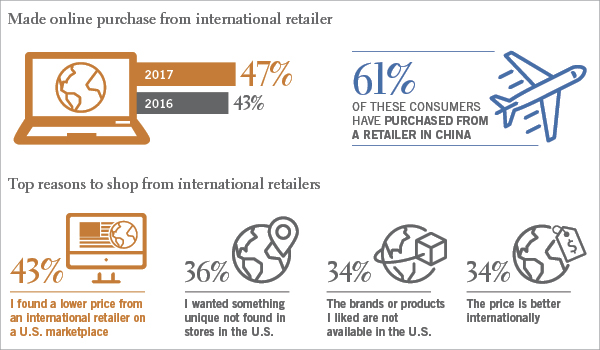U.S. Online Shoppers Click With International Retailers

Nearly half of avid U.S. online shoppers bought items from international retailers, demonstrating the need for retailers to offer more personalized services as a way to compete against lower prices, according to UPS’ sixth annual Pulse of the Online Shopper study.
Almost all avid U.S. online shoppers (97 percent), made purchases on marketplaces, up 12 points from 2016. Eighty-one percent cite price as the most important factor when searching for and selecting products online, the study finds.
According to respondents who purchased from an international retailer, 43 percent were driven by lower prices on U.S. marketplaces and 36 percent wanted unique products not found from U.S. retailers (see chart above).
“The lines that separate domestic and international retailers continue to disappear,” says Alan Gershenhorn, chief commercial officer for UPS. “Retailers are now competing across the globe. In order to win, retailers can distinguish themselves by providing value through personalized experiences.”
Personalized experiences include the physical store. Many online shoppers find stores important to touch and feel products (59 percent), solve immediate problems (54 percent), receive superior customer service (52 percent), and participate in rewards/loyalty programs (52 percent).
Half of shoppers have used ship-to-store in 2017, of whom 44 percent made additional purchases in store, and 41 percent plan to use ship-to store more often next year.
The use of smartphones continues to be an increasingly important part of the shopping experience online and in physical stores. Eight in 10 online shoppers use retailer apps, often preferring apps to websites because of faster speed and a better user experience.
The convenience factor is key as “on the go” mobile shoppers seek efficiency at every turn. Mobile coupons (50 percent) and high-quality product images (50 percent) are two of the most important app features.
“Online shoppers are able to shop the world’s boutiques and bazaars with ease,” says Gershenhorn. “We’re witnessing a glimpse of the future, when retailers and their customers will be defined less by geographic location and more by how they connect with each other. The challenge is to best provide shoppers with the choice, control, and convenience they desire.”
Global cross-border e-commerce is projected to grow at an average of 22 percent from 2015 to 2020 compared to 15 percent for U.S. e-commerce during the same time period, according to eMarketer.
The top considerations that online shoppers make when purchasing from international retailers include:
- Clearly stating the order’s total cost, including duties and fees (77 percent).
- Stating all prices in the shopper’s native currency (76 percent).
- The retailer being reputable (74 percent).
- Reasonable delivery speed (66 percent).
Of the 47 percent of U.S. consumers who purchased from an international retailer on a U.S. online marketplace, the majority of these retailers are based in China (61 percent), the U.K. (23 percent), Canada (15 percent), and Japan (14 percent).
UPS recently announced a joint venture with S.F. Holding, the parent company of China’s market-leading express delivery company SF Express. The two companies will develop shipping products designed to help Chinese companies gain greater access to the U.S. market. China is now the biggest e-commerce market in the world with approximately $900 billion USD in 2016 sales, accounting for nearly half of all digital retail sales worldwide, according to eMarketer.
